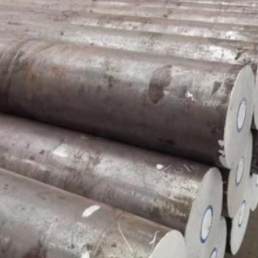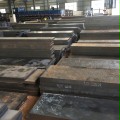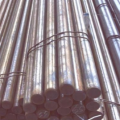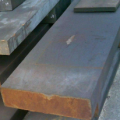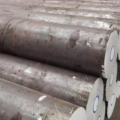Detailed Introduction
Model : T10/C105W/1.1545/TC105/SK4
Application : high speed steel
Content : Equivalent Steel with exact or nearest equivalents
|
Grade |
C |
Si |
Mn |
P |
S |
Cr |
V |
Ni |
Mo |
W |
|
T10 |
0.95-1.04 |
≤0.35 |
≤0.40 |
≤0.035 |
≤0.030 |
≤0.25 |
≤0.02 |
≤0.20 |
≤0.20 |
≤0.30 |
T10 is a high speed tool steel. Modern steel uses a combination of different steel metals to meet multiple purposes. T10 steel, composed of simple iron and carbon, accounts for 90% of the output of t10 steel products. Low-alloy high-strength steel adds a small amount (usually <2% (weight)) of other elements, usually 1.5% manganese, to provide additional strength at a moderate price increase. Corrosion-resistant steel is referred to as CRES for short. Some of the more modern steels include t10 steel, which is combined with large amounts of tungsten and cobalt or other elements to maximize the solution strengthening of t10 steel products.
T10 carbon tool steel has higher strength and wear resistance than T8 and T9, but has low thermal hardness, low hardenability and large quenching deformation, fine grains, it is not easy to overheat during quenching heating, and can still maintain fine grains Organization: There are undissolved excess carbides in the steel after quenching, so it has high wear resistance and is used to make tools with sharp edges and a little toughness. It is suitable for manufacturing various tools with poor cutting conditions, high wear resistance requirements, and is not subject to sudden and severe shock and vibration, and requires certain toughness and sharp cutting edges. It can also be used as wear-resistant parts that are not subject to greater impact. .
Characteristics: T10 is a common carbon tool steel with moderate toughness and low production cost. After heat treatment, the hardness can reach above 60HRC. However, this steel has low harden-ability and poor heat resistance (250℃). It is not easy to overheat during heating and still maintains fine grains. The toughness is acceptable, the strength and wear resistance are higher than T7-T9, but the thermal hardness is low, the harden-ability is still not high, and the quenching deformation is large.
Scope of application: This kind of steel is widely used, suitable for manufacturing various tools with poor cutting conditions, high wear resistance, and no sudden and severe shock and vibration, which require a certain degree of toughness and sharp cutting edges, such as turning tools , Planer, drill, tap, reaming tool, screw die, milling cutter, hand saw blade, cold heading die, punching die, wire drawing die, cold extrusion die for aluminum alloy, paper blanking die, plastic molding die , Small size cold trimming die and punching die, low-precision and simple-shaped measuring tools (such as pallets, etc.), can also be used as wear-resistant parts that are not subject to greater impact.
Delivery status: The steel is delivered in an annealed state. By mutual agreement, it is also possible to deliver goods without annealing.
Chinese standard grade T10 steel, China Taiwan CNS standard grade SK105/SK95, German DIN standard material number 1.1645, German DlN standard grade C105W2, Russian r0CT standard grade Y10; Japanese JIS standard grade SK105/SK95, French AFN0R standard grade Y1105, French NF Standard grade C105E2U, Italian UNI standard grade C9SKU/C100KU, Swedish SS standard grade 1880, Spanish UNE standard grade F.515/F.516, American AISL/SAE/ASTM standard grade W1-91/2, American UNS/ASM standard grade 172301, British Tun BS standard grade 1407, Korean Mantis standard grade STC3/STC4, International Organization for Standardization (lS0) standard grade TC105.
T10 application:
1) When used to make general punching dies, the production batch is less than 100,000 pieces, the material to be punched is soft low-carbon steel, and the material thickness is less than 1mm.
2) It is used to make cold drawing and deep drawing dies. After the wear is out of tolerance during work, it can be tempered at high temperature first, and then re-quenched. It can be repaired by shrinkage.
3) It is used to make long shear blades for medium and thick steel plates with a shear thickness of 11mm. After thin shell quenching, the fatigue resistance is high, the chipping tendency is small, and the life of 9CrWmn steel is 7 times longer.
4) It is used to punch small holes on soft silicon steel sheets. When the hardness is 60 ~ 62HRC, the service life can reach 20,000 to 30,000 times; when the hardness is 56 ~ 58HRC, the service life is only 9,000 times, because The burrs are too large to fail.
5) Used to make punches, dies, and inserts for blanking dies with a material thickness of <3mm. The hardness is 58 ~ 62HRC when making the convex mold, and the hardness is 60 ~ 64HRC when making the concave mold.
6) For the production of punches, dies, and inserts for bending dies. When making the punch, the hardness should be 56~60HRC, and when making the concave mould, the hardness should be 56~60HRC.
7) Used to make punches, dies, and inserts for general drawing dies. It is required that the hardness should be 58 ~ 62HRC when making the convex mold, and the hardness should be 60 ~ 64HRC when making the concave mold.
8) When used to make the concave die in the cold extrusion die of aluminum parts, the hardness should be 62~64HRC.
9) Used to make cold work molds with small size, simple shape and light load.
10) It is used for various cold stamping dies in small and medium production batches, as well as integral cold heading dies, punching and shearing tools that need to be used in the hardened state of the thin shell.
11) Make cold-working punch (punch) with light load and small size, with a hardness of 53~60HRC; make a cold heading die for hexagon nuts, with a hardness of 48-52HRC.
12) Suitable for various small and medium production batch molds and shock-resistant molds.
13) 9CrWMn steel is used to make long shear blades with a shear thickness of 11mm for medium and thick steel plates. Although the shear blade is easy to harden, it is easy to chip during use, and the service life of the shear blade is short. After switching to T10A steel to make the cutting blade, due to the thin shell hardening, the resistance to fatigue is improved, the tendency to chipping is reduced, and the service life of the cutting blade is prolonged by 7 times.
14) The T10A steel punch with hardness of 56~58HRC punches small holes in the soft silicon steel sheet. After only a few thousand pieces, it fails due to excessive burrs. If the hardness of the punching die is increased to 60~62HRC, the service life can be increased to 20,000 to 30,000 times. If you continue to increase the hardness of the mold, it is prone to early fracture, which will reduce the life of the mold.
15) The cold heading die made of this steel has a deep and steep cavity. Early collapse and failure often occur during use, and the service life of the punch is less than 4000 times. After analysis, the reason is that the feed rate is too large during cavity grinding, and the burn is softened. After improving the grinding process, the service life of the light punching was significantly increased, stabilizing at more than 30,000 times.
16) When the steel is used to make cold-punching dies, when punching thin steel plates with bright surfaces, the tool can be punched about 30,000 times per sharpening; when the black iron sheet (hot-rolled steel plate) of the same thickness is used, the service life is reduced to About 17,000 times. Although there is no oxide scale on the surface of the semi-hot rolled washed steel plate, there is a "hard crust", which will seriously reduce the service life of the die.
17) The shears of the shears are made of this steel.
18) The steel cold heading die is short-time heating and quenching at low temperature, and the twin martensite structure is obtained when treated according to the original process (780°C×20min salt bath heating and quenching), and there are microcracks under the impact of the impact load. Due to the toughness Poor, often produce chipping. Now, it is quenched by salt bath heating at 750°C×14min. After tempering at 200°C, fine flake martensite and low-carbon martensite with a volume fraction of 50% or more can be obtained, which reduces microcracks. While ensuring high hardness, it has high toughness, which increases the life expectancy by nearly two times.
19) The steel can be used to make wire drawing dies and simple punching dies.
20) Salt bath graded quenching of T10A steel plastic mold ejector rod adopts salt water and oil double liquid quenching. The deformation is large, but the oil quenching hardness is low. Using nitrate bath graded quenching, the life is increased by 1 to 3 times.
21) Hardened steel for plastic molds, suitable for making plastic molds with small size, small stress, simple shape and low deformation requirements.
22) Used for guide post, guide sleeve, pusher guide post, pusher guide sleeve, quenching hardness 50~55HRC.
23) Used for inclined pins, sliders, and locking wedge of plastic molds, with a quenching hardness of 54~58HRC.
24) Used for push rods and push tubes, with a quenching hardness of 54~58HBC.
25) Used in the feeding chamber and plunger, the quenching hardness is 50 ~55HRC.
26) Used for cores, punches, cavity plates, inserts, with a quenching hardness of 46~52HRC, and can also be used for small cores and parts of thermosetting plastic molds.
27) Suitable for making thermosetting plastic molding molds that require high wear resistance and small size.
Solar Special Steel International Limited
Contact Person :Wendy
Telephone:+86 18688633122 whatsapp&wechat
Skype: .cid.8920082fecfa0b5c
Email:ss@solarsteel.cn


